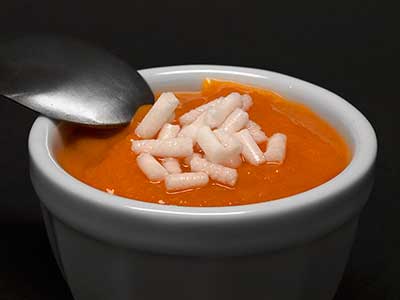February 9, 2015
Intermède

pouding de kaki
(persimmon pudding)
I went to the market today to buy some persimmons. I was looking for the non-astringent type such as the Jiro or Fuyu varieties, both common in my usual markets two days ago when I last went shopping. Today, all I could find were the Hachiya variety, the traditional astringent persimmon available in my area. Oh, well.
I wanted to make my new discovery one more time for guests before the season was over. Now, I’ll have to wait eleven months to make persimmon pudding again.
Like many of my dishes, I didn’t start out to make persimmon pudding. I wanted to make a persimmon ambrosia. I had a couple of the non-astringent type of persimmons that I’d peeled and cut into chunks. I placed these in my high-power, high-speed blender along with a splash of a sweet dessert wine. After a thorough run, I started to divide the thick puree between serving glasses, but it was too thick to pass through the wide-mouth funnel I use to neatly fill small glasses. With a shrug, I divided the puree between small bowls using a spoon. The bowls were set in my refrigerator to chill.
When I checked on the bowls of persimmon puree an hour or so later, they had gelled solid. I had filled an extra bowl so I sampled the “pudding.” The texture was still soft, not overly firm. The gel was very friable. The gel held for a number of days without the puree oxidizing although it did exhibit some syneresis after about three days.
What was happening here? It didn’t really matter, I liked the results. But I was curious. I searched for an answer on the Internet and poured through my 1984 edition of Harold McGee’s On Food and Cooking: The Science and Lore of the Kitchen. I found no explanation. So I emailed Harold:
I’ve been trying to understand a reaction I’ve seen in my kitchen, but to date, I have not been able to find any research to explain what’s happening. I’ve been making various fruits purees to use as a palette cleanser. Peaches, pears, and the like pureed in the Vitamix with a splash of a cheap dessert wine have produced a very drinkable couple of swallows. Two weeks ago, finding myself with a handful of either Fuyu or Jiro persimmons—I can’t tell the difference without a package label—proceeded to puree those in the same manner. The initial puree was only slightly thicker than I had seen with other fruit, but by the next day, a friable gel had formed. About half a week later, the gel is demonstrating syneresis. I’m guessing that some of the pectins are getting sheared, and that they are then cross-linking to form the gel. (Emphasis on the word “guessing”.) What do you think is causing the gel to form?
He was kind enough to respond:
Not sure if you have a copy of [the] out-of-print CURIOUS COOK, but I wrote at length about the peculiarities of Hachiya persimmons, and I think something similar is going on with your Fuyu-Jiros. Persimmons are rich in polyphenols, and they are capable of cross-linking proteins as well as pectins to form a gel. With Hachiyas this is almost instantaneous. The wine’s alcohol may help with this, because it precipitates pectins.
I have a copy of the 1990 Curious Cook, but I didn’t think to look in it. But now I also had my answer, the polyphenols in the persimmons were causing the pectin molecules to cross-link. (I also found out that I was not the first person to thicken persimmon puree in a blender.)
For serving, the little bowls of persimmons looked a bit forlorn. They needed something to liven up their appearance. Some rice-like pellets of sugar called zucchero granella per guarnire dolci (sugar grains for sweet garnishing) that I picked up a few years earlier in Italy did the trick. They made a nice garnish for the pudding.
© 2015 Peter Hertzmann. All rights reserved.
